Pork tenderloin is one of the most versatile cuts of meat you can put on your table. It’s lean, flavorful, and easy to prepare, making it an affordable and delicious option for any meal. One of the most common questions when cooking pork tenderloin is how long to cook it in the oven. If you’re cooking pork tenderloin in the oven at 400 degrees Fahrenheit, you need to know a few key things to ensure it’s perfectly cooked every time.
We’ll teach you how long to cook pork tenderloin in the oven at 400 degrees Fahrenheit to achieve the most succulent and juicy results. So if you want to impress your friends and family with top-notch pork dishes, you’ve come to the right place! So grab your favorite apron, preheat your oven, and let’s get cooking!
What Is Pork Tenderloin?
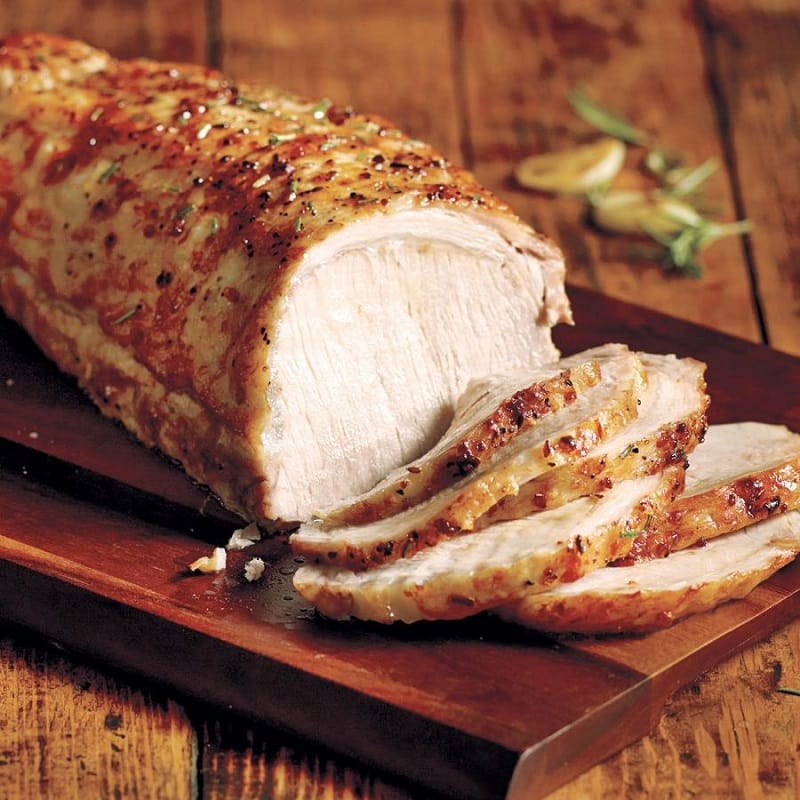
Pork tenderloin is a popular cut of meat that many people enjoy but may not know much about. As someone who has often cooked and eaten pork tenderloin, I can tell you firsthand that it is a delicious and versatile cut of meat that can be prepared in various ways.
First of all, let’s define what pork tenderloin is. It is a long, thin cut of meat from the pig’s loin, which runs from the shoulder to the hip. It is often referred to as the “other white meat” because it is leaner than other cuts of pork and has a mild, slightly sweet flavor.
One of the great things about pork tenderloin is that it is very easy to prepare. It can be grilled, roasted, sautéed, or even cooked in a slow cooker. Because it is so lean, it cooks quickly and doesn’t require a lot of seasoning or marinating to be flavorful.
One of my favorite ways to prepare pork tenderloin is to season it with a mixture of salt, pepper, garlic, and rosemary, then sear it in a hot skillet before finishing it in the oven. This creates a flavorful crust on the outside of the meat while keeping the inside juicy and tender.
Pork tenderloin can also be sliced into medallions, used in stir-fries or salads, or sliced thin and used in sandwiches or wraps. It pairs well with various flavors, including sweet and savory sauces, fruit salsas, and tangy marinades.
Nutritional Facts Of Pork Tenderloin
As someone who enjoys cooking and eating pork tenderloin, I became curious about its nutritional value. After researching, I was pleasantly surprised that pork tenderloin is a healthy choice.
First and foremost, pork tenderloin is a great source of protein. A 4-ounce serving contains around 22 grams of protein, making it an excellent choice for those looking to build and maintain muscle. Additionally, pork tenderloin is low in fat and calories, with just 120 calories and 3 grams of fat per serving.
What’s more, pork tenderloin is packed with important vitamins and minerals. It’s a good source of vitamin B6, which helps support brain function and the immune system. It’s also rich in thiamin, which is important for energy production, and niacin, which can help lower cholesterol levels.
When it comes to minerals, pork tenderloin is a good source of iron, which is essential for healthy blood cells, and zinc, which supports a healthy immune system. It also contains selenium, which acts as an antioxidant and helps protect against cell damage.
One thing to keep in mind when preparing pork tenderloin is to watch your portion sizes. While it is a healthy choice, it’s important not to overdo it. Stick to a 4-ounce serving and pair it with plenty of vegetables and whole grains for a balanced meal.
How Long To Cook Pork Tenderloin In Oven At 400?
Cooking pork tenderloin in the oven at 400 degrees Fahrenheit can be a delicious and easy meal option. The average cooking time for a 3-pound pork tenderloin is around 25 minutes, with the internal temperature needing to reach 145 degrees Fahrenheit. Using an instant-read thermometer is essential to ensure the pork is cooked correctly.
Stuffed pork tenderloin can take about 50 minutes to cook thoroughly. Cooking the meat for ten minutes in the oven before fully baking is suggested to create a crust on the pork that keeps the juices in. The exact cooking time may depend on the size of the tenderloins, but a good rule of thumb is around 20 to 25 minutes at 400 degrees Fahrenheit. Remember to line a baking sheet with foil before cooking to make cleaning easy.
How Long To Cook Pork Tenderloin In Oven At 400 Without Searing?
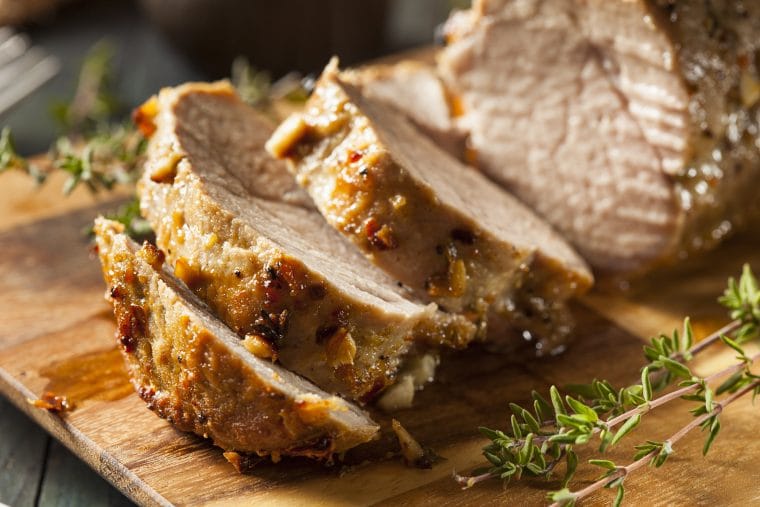
If someone wants to know how long to cook pork tenderloin in the oven at 400 degrees without searing, they can expect it to take 20-25 minutes. It’s important to note that pork tenderloin traditionally has a crust, achieved by searing it in a pan before roasting it.
However, if someone prefers not to sear the pork, it’s still possible to get a delicious result without a crust. Generally, one should plan on cooking a rolled pork tenderloin for 45 minutes per pound. However, if someone chooses not to sear it, they can reduce the cooking time to just over 30 minutes. If they don’t have a thermometer, they can cook it for 15-20 minutes and then touch the thickest part of the meat to check if it’s done. The internal temperature should be 145 degrees Fahrenheit.
What Is The Ideal Cooking Time For A 1-Pound Pork Tenderloin At 400 Degrees Fahrenheit?
If you plan to cook a 1-pound pork tenderloin in the oven at 400 degrees Fahrenheit, the ideal cooking time can differ depending on various factors, like the thickness of the meat. Baking it for about 20 to 25 minutes per pound is recommended. So, the perfect cooking time for a 1-pound pork tenderloin would be around 20 to 25 minutes.
However, it’s always advisable to check the internal temperature of the pork using a meat thermometer to ensure it reaches the safe cooking temperature of 145 degrees Fahrenheit.
How Do I Ensure My Pork Tenderloin Is Cooked To The Correct Temperature At The Center?
As someone who loves to cook, I know how important it is to ensure that your pork tenderloin is cooked to the correct temperature at the center. Not only does it affect the taste and texture of the meat, but it’s also essential for food safety.
To start, you’ll need a meat thermometer. This is the most accurate way to determine the internal temperature of your pork tenderloin. Make sure to insert the thermometer into the thickest part of the meat, avoiding any bones or fat, as these can give you an inaccurate reading.
The recommended internal temperature for pork tenderloin is 145°F (63°C). However, this doesn’t mean you should remove it from the oven or off the grill when it hits this temperature. It’s essential to let the meat rest for at least three minutes after it’s been removed from the heat source. During this time, the temperature will continue to rise, and the juices will redistribute, resulting in more tender and flavorful pork tenderloin.
If your pork tenderloin is still not cooked to the correct temperature after resting, you can always put it back in the oven or on the grill. Just be sure to use a timer and check the temperature regularly to avoid overcooking.
It’s also worth noting that the color of the meat is not always an accurate indicator of whether it’s cooked through or not. Pork tenderloin can be pink or slightly pink when cooked to the recommended internal temperature, so don’t rely solely on color to determine if it’s done.
What Is The Best Temperature To Cook Pork Tenderloin In The Oven?
When cooking pork tenderloin in the oven, the best temperature to cook it at is 400°F. This temperature allows the tenderloin to cook evenly without drying out, resulting in juicy and tender meat. The cooking time will depend on the size and thickness of the pork tenderloin, but it typically takes around 25-30 minutes to cook a 1.25-pound tenderloin. An instant-read thermometer is important to ensure the internal temperature reaches 145°F, the recommended safe temperature for pork.
To add flavor, the tenderloin can be marinated before cooking or seasoned with herbs and spices, and for even more flavor, it can be basted with additional marinade during cooking. Overall, cooking pork tenderloin at 400°F is a reliable and delicious way to prepare this popular cut of meat.
Is Pork Tenderloin Better At 350 Or 400?
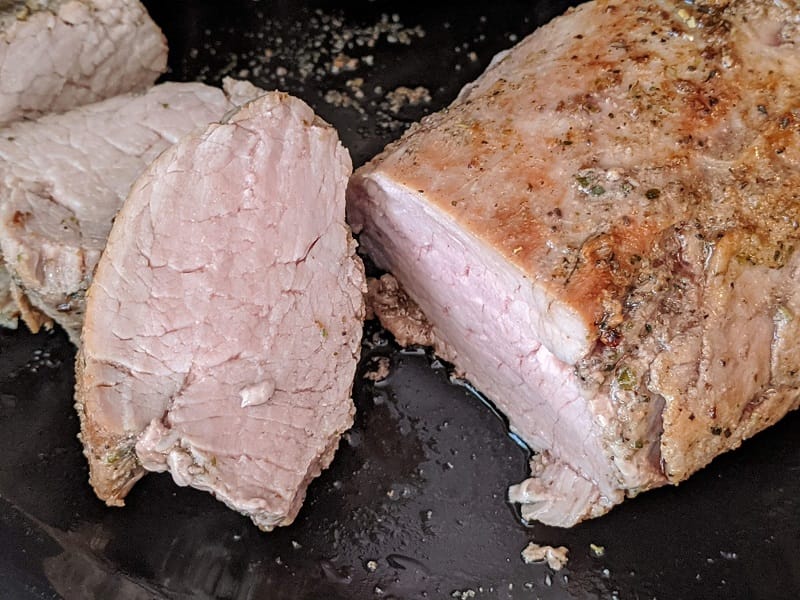
Loves cooking and experimenting with different recipes. I’ve often wondered if there’s a noticeable difference when cooking pork tenderloin at 350 versus 400 degrees Fahrenheit. So, I decided to put it to the test and share my findings with you.
After conducting my experiment, I’ve concluded that cooking pork tenderloin at 400 degrees Fahrenheit is the better option. Here’s why:
- Faster cooking time: Cooking at 400 degrees Fahrenheit will result in a shorter cooking time. This is because the higher temperature will sear the outside of the meat quickly, locking in the juices and keeping the inside tender.
- Better texture: Cooking at 400 degrees Fahrenheit will also result in a crispy, golden-brown crust outside the meat. This adds an extra layer of texture to the dish and makes it more visually appealing.
- More flavorful: Cooking at a higher temperature will also give the pork tenderloin a more intense flavor. This is because the Maillard reaction occurs at higher temperatures, a chemical reaction that gives food a browned and savory flavor.
However, it’s important to note that cooking at 400 degrees Fahrenheit requires a bit of attention to prevent overcooking. I recommend using a meat thermometer to check the internal temperature of the pork tenderloin and removing it from the oven once it reaches 145 degrees Fahrenheit.
Should Pork Tenderloin Be Cooked Covered Or Uncovered?
Pork tenderloin is a lean cut of meat that can easily dry out if not cooked properly. So, after a lot of experimentation and research, I can confidently say that the answer is: it depends.
When it comes to cooking pork tenderloin, there are a few factors to consider. The first is the cooking method. Are you roasting, grilling, or searing? Each method requires a slightly different approach.
If you’re roasting pork tenderloin in the oven, it’s generally best to cook it uncovered. This allows the heat to circulate evenly around the meat, ensuring it cooks evenly. Leaving it uncovered will help the outside of the meat develop a delicious crust. Just be sure to keep an eye on it so that it doesn’t dry out.
On the other hand, if you’re grilling pork tenderloin, it’s best to cover it. This helps trap the heat and smoke, infusing the meat with flavor and ensuring it stays moist. If you’re using a gas grill, close the lid. If you’re using a charcoal grill, cover it with a lid or use foil to enclose the meat.
Lastly, if you’re searing pork tenderloin on the stove, it’s best to leave it uncovered. This will help to develop a nice crust on the outside of the meat while still keeping it tender and juicy on the inside.
Of course, there are always exceptions to the rule. For instance, if you’re cooking pork tenderloin with a marinade or sauce that contains sugar, it’s best to cook it uncovered to prevent the sugar from burning. And if you’re cooking a large pork tenderloin, you may want to cover it for the first part of the cooking time to help it cook through, then uncover it for the last part of the cooking time to let the outside develop a crust.
Can I Marinate The Pork Tenderloin Overnight, And Does It Affect The Cooking Time?
I have often found myself wondering whether or not I can marinate the pork overnight and how it might affect the cooking time. After some research and personal experience, I feel that marinated pork tenderloin overnight can enhance the flavor. Marinating is a process of soaking meat in a mixture of spices, herbs, acids, and oils to enhance the flavor and tenderness of the meat. Regarding pork tenderloin, marinating overnight can help infuse the meat with flavor and make it more tender.
However, it is essential to note that marinating can affect the cooking time of the pork tenderloin. The acid in the marinade can break down the proteins in the meat, making it more tender and causing it to cook faster. Therefore, it is important to keep an eye on the cooking time and temperature to ensure that the pork tenderloin is cooked to perfection.
When marinating pork tenderloin overnight, it is important to use a non-reactive container, such as a glass or plastic dish, as the acid in the marinade can react with metal and alter the flavor of the meat. Covering the dish with plastic wrap or a lid is also recommended to prevent contamination.
In terms of marinade options, there are countless possibilities. Some popular options for pork tenderloin include a mixture of soy sauce, honey, garlic, ginger, olive oil, lemon juice, garlic, and rosemary. It is important to note that the longer the pork tenderloin is marinated, the stronger the flavor will be.
In conclusion, marinating pork tenderloin overnight can enhance the flavor and tenderness of the meat. Still, it is important to keep an eye on the cooking time and temperature to ensure it is perfectly cooked. With the right marinade and cooking technique, delicious and flavorful pork tenderloin can be achieved every time.
Should I Wrap My Pork Tenderloin In Foil?
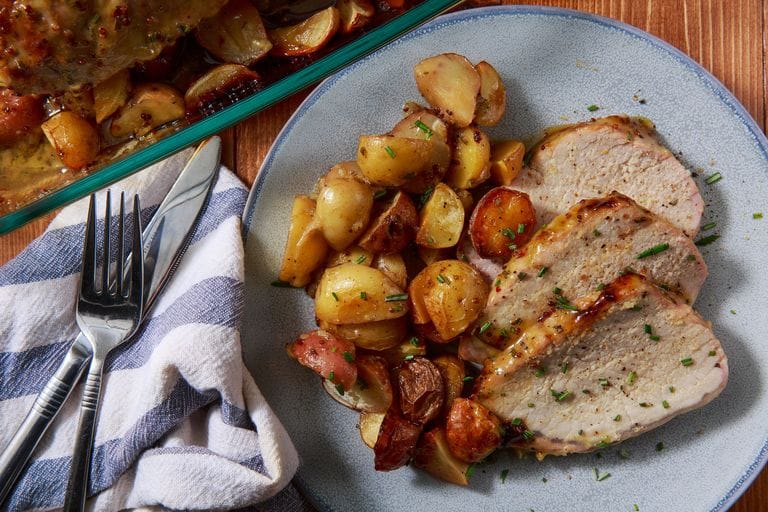
The answer is not a simple yes or no. Let me break it down for you.
First of all, let’s talk about why someone might want to wrap their pork tenderloin in foil in the first place. Wrapping the tenderloin in foil can help create a more moist and tender finished product. It also helps keep the meat from drying out during cooking. So, if you’re someone who struggles with keeping your pork tenderloin juicy and succulent, wrapping it in foil might be a good solution for you.
However, there are some downsides to wrapping your pork tenderloin in foil. One of the biggest issues is that the meat can become steamed instead of roasted. This can result in a lack of browning and a less flavorful finished product. If you value a nice crispy crust on your pork tenderloin, wrapping it in foil might not be your best choice.
So, should you wrap your pork tenderloin in foil or not? It ultimately depends on your personal preferences and cooking style. Wrapping your pork tenderloin in foil might be a good idea if you prioritize moistness and tenderness over crispy crust. However, you might want to avoid the foil if you want a nice browned crust and plenty of flavors.
Read more:
- Pork Loin Vs Pork Shoulder
- Ground Beef Vs Ground Pork
- Pulled Pork 190 vs 205
- Beef Tenderloin Vs Filet Mignon
How To Tell If Pork Tenderloin Is Cooked Without Using A Thermometer?
Frequent cook, I always try to ensure that the meat I prepare is cooked thoroughly to avoid any potential health risks. One of the most challenging meats to cook perfectly is pork tenderloin, and sometimes, you may not have a thermometer to check if it’s cooked as thoroughly as you’d like it to be. But don’t worry. You don’t necessarily need one to tell if your pork tenderloin is cooked!
First, you can use the touch test. This method involves using your fingers to determine the firmness of the meat. If the pork tenderloin is still squishy, it’s not cooked through. If it feels firm but still has some give, it’s medium. And if it’s firm to the touch, it’s well done. However, keep in mind that this method may not be entirely accurate, as different cuts of meat have varying levels of firmness.
Another way to tell if your pork tenderloin is cooked is to look at the color of the meat. If the meat is still pink, it’s not cooked through yet. If it’s slightly pink and has a light brown color, it’s medium. And if the meat is entirely brown, it’s well done. However, be mindful that some pork tenderloin may still be pink even when cooked.
One final way to ensure that your pork tenderloin is cooked is to check the juices. To do this, pierce the meat with a fork or knife; it’s not cooked if the juices are pink or red. If the juices are clear, it’s well done. However, this method should be used with caution, as piercing the meat can cause it to lose its juices, resulting in a dry and tough cut of meat.
How To Cook Pork Tenderloin At 400 Degrees?
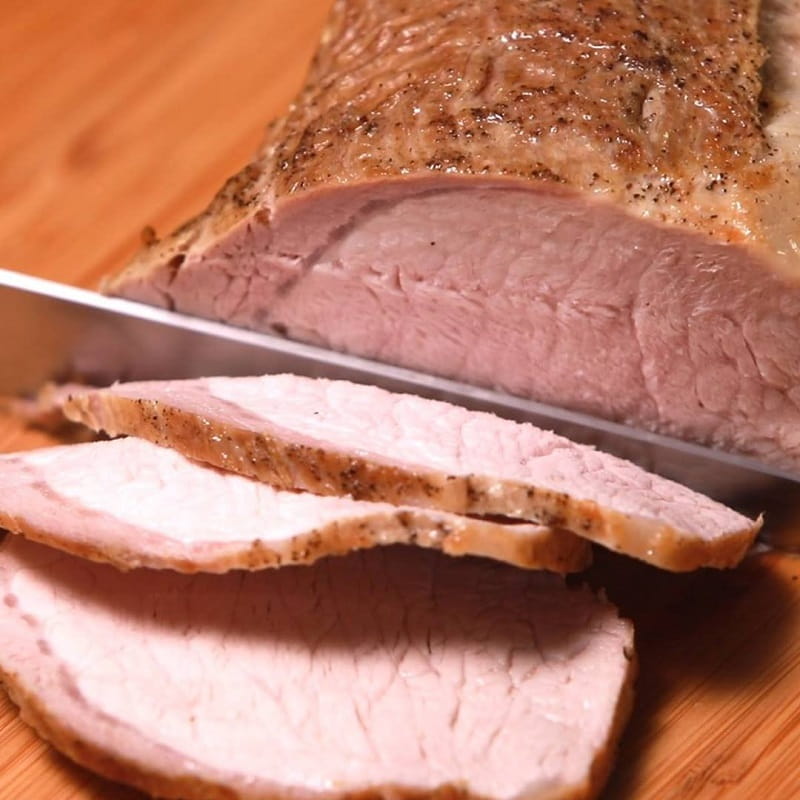
Are you ready to learn how to cook pork tenderloin at 400 degrees? I’m excited to share my recipe and guide you through the steps.
First, let’s gather our ingredients. You’ll need the following:
- One pork tenderloin
- One tablespoon of olive oil
- Half a teaspoon each of garlic powder
- Onion powder and paprika
- A quarter teaspoon each of ground mustard
- Salt
- Ground black pepper
- One tablespoon of brown sugar
Now that we have everything we need, let’s get started.
- Let’s preheat our oven to 400 degrees Fahrenheit and lightly spray a casserole dish or baking dish with non-stick cooking spray.
- Next, we’ll combine our spices and brown sugar in a small bowl. This mixture will be the seasoning for our pork tenderloin.
- Take the pork tenderloin and place it in the baking dish. Rub it with the olive oil and sprinkle the seasoning mix over it. Make sure to cover all sides of the pork with the seasoning.
- Now, it’s time to bake our pork tenderloin. Pop it in the oven and bake for 20-25 minutes or until the internal temperature reaches 145 degrees Fahrenheit. If you prefer your pork fully cooked without any pink in the center, cook it for 25-30 minutes.
- Once the pork tenderloin is done cooking, please remove it from the oven and let it rest for about 5 minutes on a cutting board. This will allow the juices to redistribute throughout the meat, making it juicier and more flavorful.
- Now that our pork tenderloin has rested, it’s time to slice it up and enjoy! This recipe is perfect for a weeknight dinner or a special occasion. It’s easy to make and packed with flavor.
I hope you found this recipe helpful and easy to follow. Give it a try, and let me know how it turns out for you! Remember, cooking is all about having fun and experimenting with different flavors.
How Can I Make Sure That The Pork Tenderloin Is Evenly Cooked And Does Not Dry Out?
I’ve learned a few tricks to ensure it always comes out perfectly. One of the biggest challenges with cooking pork tenderloin is ensuring it is evenly cooked and doesn’t dry out. Here are some tips that have worked for me:
- Brine the pork tenderloin: Bringing it before cooking can help keep it moist and tender. A simple brine solution can be made by dissolving salt and sugar in water and adding any herbs or spices you like. Soak the pork tenderloin in the brine for at least a few hours before cooking.
- Use a meat thermometer: One of the best ways to ensure that your pork tenderloin is perfectly cooked is to use a meat thermometer. Insert the thermometer into the thickest part of the pork tenderloin to check the internal temperature. Pork tenderloin should be cooked to an internal temperature of 145°F.
- Let the pork tenderloin rest: After cooking, allow the pork tenderloin to rest for at least 5-10 minutes before slicing. This allows the juices to redistribute throughout the meat, making it more tender and juicy.
- Sear the pork tenderloin: Searing the pork tenderloin before roasting can help to seal the juices and create a flavorful crust. Heat a skillet over high heat and add oil. When the oil is hot, add the pork tenderloin and sear on all sides until browned.
- Use a marinade: A flavorful marinade can also help to keep the pork tenderloin moist and add flavor. You can use a store-bought marinade or make your own with ingredients like oil, vinegar, soy sauce, and herbs.
Tips For Cooking Pork Tenderloin In Oven
I’ve always loved cooking pork tenderloin in the oven. It’s a simple yet flavorful dish that’s perfect for any occasion. Over the years, I’ve learned a few tips and tricks that have helped me perfect my recipe. Here I’ll share those tips with you so you can cook a delicious pork tenderloin in the oven.
- Tip #1: Choose the right cut of pork tenderloin. When selecting your pork tenderloin, look for uniform size and shape. This will ensure that it cooks evenly in the oven. Also, ensure that the meat has little to no fat. This will prevent the meat from becoming tough and chewy.
- Tip #2: Season the pork tenderloin. Before placing the pork tenderloin in the oven, season it with a dry rub or marinade. This will add flavor to the meat and help it cook evenly. Some of my favorite seasonings for pork tenderloin include garlic, rosemary, and thyme.
- Tip #3: Preheat the oven. To ensure that your pork tenderloin cooks evenly, preheat your oven to 375 degrees Fahrenheit. This will allow the meat to cook at a consistent temperature, resulting in juicy and tender pork tenderloin.
- Tip #4: Use a meat thermometer. Use a meat thermometer to check the internal temperature to ensure that your pork tenderloin is perfectly cooked. The ideal temperature for cooked pork tenderloin is 145 degrees Fahrenheit. Once the meat reaches this temperature, remove it from the oven and rest for 5-10 minutes before slicing.
- Tip #5: Slice the pork tenderloin properly. When slicing your pork tenderloin, be sure to cut against the grain. This will ensure that the meat stays tender and juicy. Also, be sure to slice the meat into thin pieces to make it easier to eat.
How Do You Store Leftover Pork Tenderloin?
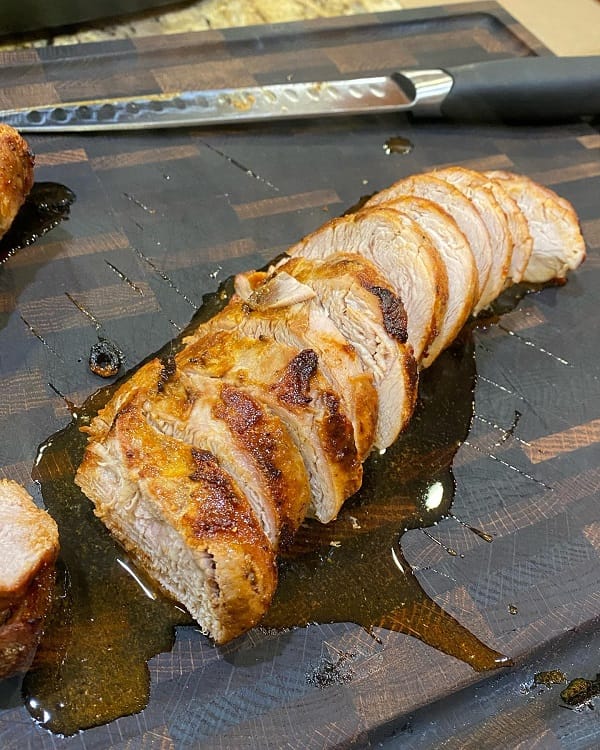
When to cook, I inevitably end up with leftovers from time to time. One dish that always seems to have leftovers is pork tenderloin. And while I love being able to enjoy the deliciousness of this dish the next day, I often struggle with how to store it properly. So, how do you store leftover pork tenderloin?
First and foremost, it’s essential to ensure the pork tenderloin is fully cooked before storing it. This will help prevent any foodborne illnesses from developing. Once the pork is cooked, allow it to cool completely before storing it.
When it comes to storage, there are a few options. One option is to store the pork tenderloin in an airtight container in the fridge. This will keep the pork fresh for a few days. If you plan to store it for longer than a few days, you may want to freeze it.
To freeze leftover pork tenderloin, wrap it tightly in plastic wrap or aluminum foil and then place it in a freezer-safe bag or container. Be sure to label the container with the frozen date so you know how long it has been in the freezer.
When you’re ready to enjoy your leftover pork tenderloin, there are a few different ways to reheat it. One option is to microwave it, although this can sometimes make the pork tough and dry. Another option is to reheat it in the oven at a low temperature, around 275°F, until warm.
FAQs About How Long To Cook Pork Tenderloin In Oven At 400
Can The Pork Tenderloin Be Flipped Over During Cooking For Even Browning?
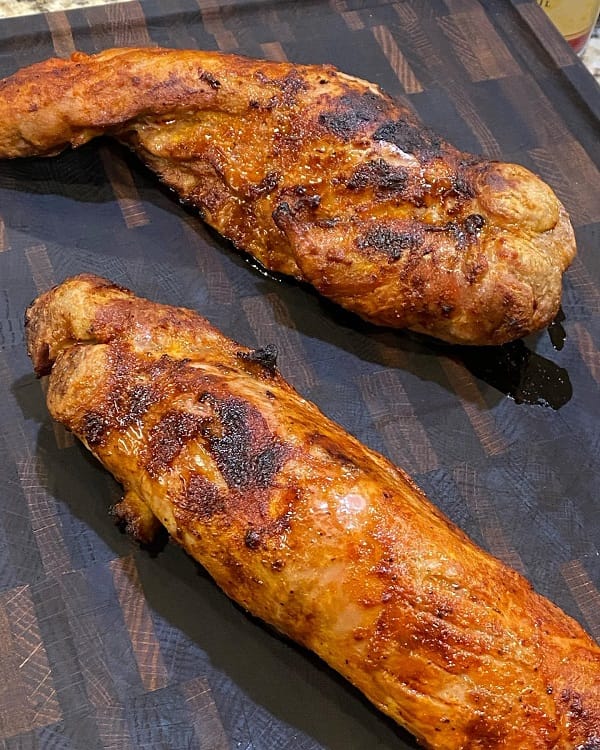
When cooking pork tenderloin, it can be beneficial to flip it over during the cooking process to ensure even browning. The USDA guidelines state that pork should be cooked to 145°F for medium-rare, which is perfectly safe. Flipping the tenderloin halfway through the oven-roasting period is recommended for best results. Additionally, searing all sides until golden brown is a great way to achieve a tasty crust.
It’s important never to marinate the pork for longer than 24 hours and to carefully trim the tenderloin before cooking. Once cooked, the pork should be sliced against the grain into thinner slices for best results.
Should I Sear The Pork Tenderloin Before Putting It In The Oven, And How Does This Affect The Cooking Time?
When it comes to cooking pork tenderloin, searing it before roasting is a great idea. Not only does it give the meat a beautiful golden crust, but it also adds flavor to the dish. The recommended searing time is 2-3 minutes on each of the three sides before transferring it to the oven.
While you can sear the tenderloin on all four sides, searing it on two sides will work fine. However, it’s not a big deal if you don’t have a cast iron skillet. You can still achieve great results without it. Keep in mind that an even cut is essential for even cooking, and checking the interior temperature of the meat is necessary to ensure that it’s cooked correctly. Overall, searing the meat first and then finishing the cooking process in the oven results in a perfectly cooked, juicy, and delicious pork tenderloin.
What Are Some Recommended Seasoning Options For Pork Tenderloin Before Cooking?
There are plenty of options if you are looking for some delicious seasoning options for pork tenderloin before cooking. Some popular choices include garlic powder, onion powder, oregano, cumin, thyme, paprika, and salt.
To make a rub, mix these spices with a small amount of brown or coconut sugar in a bowl, then rub the mixture over the pork loin. Poultry seasoning with sage and thyme can also be used for added flavor. It’s important to wrap the seasoned meat tightly in plastic wrap and refrigerate it for at least four hours before cooking to give the spices time to infuse it.
How Long Do I Grill Pork Tenderloin At 400?
If appropriately grilled, pork tenderloin can be cooked at 400 degrees Fahrenheit. The cook should aim for a 400-450 degrees Fahrenheit surface temperature for the best results. The cooking time of pork tenderloin varies based on a few factors, such as thickness and cooking method.
Generally, it takes approximately 15 minutes to cook over high heat on a grill or 20-25 minutes in an oven at 400 degrees. It is important to monitor the internal temperature of the pork tenderloin and remove it from the heat source when it reaches 140°F to 145°F.
Will Marinating Pork Tenderloin Make It More Tender?
The answer is yes. By marinating the pork medallions overnight, the meat gets immersed in a mixture of liquids and seasonings, which penetrate the surface of the meat, giving it a sweet and salty flavor. Moreover, marinating helps break down the protein fibers in the meat, making it more tender and juicy, especially when cooked quickly at high temperatures. However, avoiding marinating pork for more than 24 hours is essential, as it can lead to a mushy texture.
Why Is Pork Tenderloin So Lean?
The answer lies in the anatomy of the pig. Pork tenderloin comes from a muscle that runs along the pig’s spine, and this muscle is not used for movement or support like other muscles in the animal’s body. Because this muscle is not worked as hard, it contains less fat and is leaner. Additionally, pork tenderloin is a smaller cut of meat than pork loin, which means it contains less fat overall.
Despite its leanness, pork tenderloin is still packed with flavor and nutrition, making it a favorite among health-conscious consumers. Whether grilled, roasted, or pan-seared, pork tenderloin is an easy and delicious option for any weeknight meal.
Should Pork Tenderloin Be Cooked Fast Or Slow?
If you’re wondering whether you should cook pork tenderloin fast or slow, the answer is fast. Due to its lean texture, pork tenderloin cooks quickly, making it ideal for a weeknight dinner. Cooking at a high temperature for a short period of time prevents the meat from drying out and keeps it tender and juicy. While slow cooking is a popular method for many other cuts of pork, it’s not recommended for tenderloin as it can result in a tough texture.
Conclusion
In conclusion, cooking pork tenderloin in the oven at 400 degrees Fahrenheit for 25-30 minutes is a simple and delicious way to prepare this versatile cut of meat. It’s important to note that the cooking time will vary depending on the size of your pork tenderloin. By searing the meat beforehand and using a meat thermometer to ensure it reaches the proper internal temperature, you can create a perfectly cooked and flavorful dish every time.
And that’s all there is to it! Now you know how long to cook pork tenderloin in the oven at 400 . With this information in hand, you’re ready to tackle dinner tonight.
References:
- https://www.freep.com/story/entertainment/dining/2022/06/25/marinating-pork-tenderloin-medallions-key-making-them-juicy/7698506001/
- https://www.thekitchn.com/how-to-grill-the-juiciest-pork-tenderloin-in-under-30-minutes-244719
- https://www.today.com/food/how-cook-pork-tenderloin-t218441
- https://www.saltandlavender.com/baked-pork-tenderloin/

Hey readers! Chip Holland here, and I’m a Manager of this website. My passion for writing about it only matches my passion for BBQ. Follow my blog for mouth-watering recipes, tips, and tricks for the perfect smoke, grill, and BBQ. I’m sure you won’t be disappointed!
